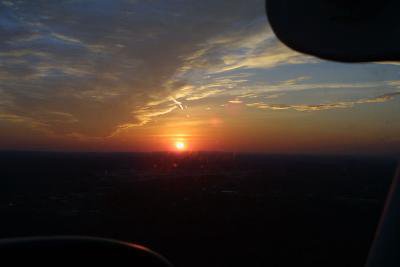Multi-engine training -- Day 2
This morning was spent reviewing the Seminole's performance charts, which help the pilot calculate take-off and landing distances in various atmospheric and loading conditions as well as accelerate-stop distance in the event of an engine failure on the runway. We also discussed what to do if an engine were to quit at various times during flight operations.
After a quick weight and balance problem, it was on to simulator training.
Like many other sims, this one -- a Frasca -- is very twitchy and pitch sensitive and requires some finesse to control. It's not so much designed to teach a student how to fly the plane but rather to practice procedures and flows and get familiarized with the cockpit.
I was a little concerned about flying it but got a feel for it within minutes. Flying it in IMC will be a different story altogether, however.
After going through the engine start procedures, we began flight maneuvers with steep turns, which presented no problems. Then came slow flight, which while simple in the 172 proved a little trickier in the sim since I'd never flown a variable-pitch constant-speed propeller plane before. While the workload involved isn't much greater than that of flying a fixed-pitch aircraft, it takes some time to get adjusted to monitoring both an RPM and manifold pressure gauge and moving an extra set of levers to set the angle of the propeller blades. Oh, and of course because in addition to it the Seminole is a twin, I am now responsible for not one engine control lever (or two including the mixture) but four (two throttles, two prop controls) or six, including the mixture control.
But with time, I began to get the hang of moving the levers together and matching performance on both engines. We did a couple of stalls, which are simple maneuvers but had me fall behind on the list of procedures established by the school.
Next up was Vmc demo, which involves simulating an engine failure by pulling back the throttle and slowing the airplane to the speed at which directional control is lost. (Vmc is the minimum speed at which directional control is maintained with the critical engine failed). Again, the maneuver is in and of itself reasonably simple but while I wrestled the sim I found myself forgetting the various steps involved.
After three or four demos, I was doing ok. As mentioned above, the exercise consists of simulating a failure of the left engine by retarting the throttle. Right rudder must then be applied to counter left-turning forces and a gentle bank into the operating engine is called for to achieve a zero sideslip condition, thereby reducing drag from the fuselage flying cock-eyed into the relative wind.
Pitch is increased and as the airspeed drops, more rudder is needed to maintain heading and foiling the aircraft's nasty plans to roll into the dead engine. Quite interesting and definitely challenging. I wonder what it'll be like in the plane.
After that, the instructor let me fly straight and level for a while. When I asked what we were doing, he simply replied "We're cruisin'."
Something was amiss, for sure.
A second later, the plane rolled and yawed left. Engine failure.
Emergency checklist: maintain directional control, mixtures, props, throttles full forward, flaps and gear up, identify the failed engine, verify by pulling back the throttle (a change in performance would obviously indicate that the wrong engine is about to be shut down). Since we were above 3,000 AGL, I decided to troubleshoot the failure, but to no avail so opted to feather and secure the dead engine.
Once all the checklists were complete, we did an air restart and called it a day.
My slowness in flowing through the procedures for each maneuver frustrated me, so I'm memorizing those and running through the flows by "chair-flying" them in front of a poster of the Seminole's cockpit tonight. I also ran through the checklists from start-up to shutdown to become more familiar with them and my night will end with more reading from the aircraft's POH, which is turning out to be quite a fascinating book!
Tomorrow: Sim in the morning and finally, weather allowing, a couple of hours in the Seminole to practice maneuvers.
Woohoo!
Update: My multi-engine checkride, originally scheduled for next Tuesday, might be moved up to Saturday. And to add to the excitement there might be an FAA inspector in the back, who will be recertifying the examiner giving me the exam. I don't know what to think of that, although on the upside the checkride would be free...



5 Comments:
Keep up the good work, Mark - and the posts. You really know how to make a guy jealous!
Hey Mark-
Great posts. I just came across your site from Glenn's RantAir site. I am starting my CFI/CFII in the next week and then will get my multi. I thought about doing it at ATP, but i would have to be away from home too long. Sounds like things are going well. Keep it up & good luck to you!!
Great to hear you've started the multi-engine experience! The Seminole is a great platform - docile and stable. Practice those flow checks!
Thanks guys. I'm having a ball with training! As noted in a new post, I've flew the plane for the first time yesterday and again today, for 4.3 hours and am loving it. Everything is falling into place and my confidence level is definitely up. I think I can do this thing!
Good advice, John... back to the flows I go!:)
Very nice ppost
Post a Comment
<< Home